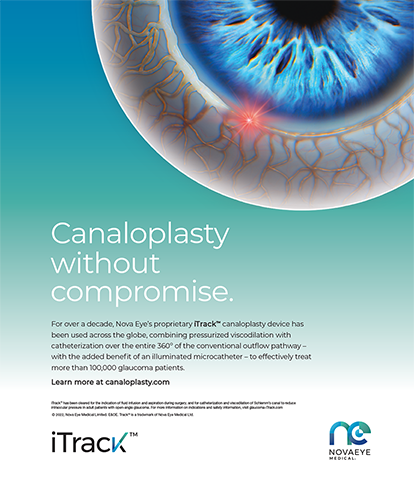What methods have you adopted to help decrease endothelial trauma when removing dense, brunescent nuclei?
—Topic prepared by R. Bruce Wallace III, MD.
JOHN A. HOVANESIAN, MD
The first rule for avoiding endothelial trauma during cataract surgery on an eye with a dense nucleus is to take your time. Although we cataract surgeons want to minimize unnecessary fluid turnover and the excessive use of phaco energy, in a challenging situation, the most efficient surgery is performed when we slow down and methodically perform the steps with which we are so familiar. Novice surgeons who are in a hurry to finish a tough case often make avoidable mistakes in haste.
During nuclear removal, I work in the posterior chamber as much as possible. It may be wise to use a dispersive rather than a cohesive ophthalmic viscosurgical device (OVD) to coat the endothelium. I refill the posterior chamber with an OVD after about 30 seconds of phaco time have elapsed. At the end of the case, it is not necessary to remove all of the viscoelastic that is adherent to the endothelium; doing so may induce unnecessary endothelial trauma. A little bit of retained OVD may cause a brief spike in IOP, but this challenge is much easier to control than severe endothelial loss.
JAMES C. LODEN, MD
The first and greatest pearl for protecting the endothelium during the extraction of a dense cataract is to select a dispersive OVD and use it liberally. For dense cataracts, I always coat the endothelium with either Viscoat (Alcon Laboratories, Inc.) or Endocoat (Abbott Medical Optics Inc.). In my hands, these two OVDs do a superior job of maintaining endothelial integrity during extended phaco times with high flow and high vacuum settings. I never hesitate to recoat the endothelium halfway through quadrant removal if I suspect that the OVD protection is less than adequate.
I also prefer a stop and chop technique for dense nuclei. With this technique, I can emulsify as much of the nucleus as possible, as far from the cornea as possible, without compromising the posterior capsule. The most important step is making a deep groove and getting an adequate crack through the dense posterior lamellae of a brunescent lens. To facilitate this groove and chop, I fixate the distal rim of the nucleus using a Conner Wand (Rhein Medical, Inc.) or another horizontal chopper. The chopper provides countertraction so that I can use the phaco handpiece to create a deep groove and obtain a full-thickness chop (Figure 1). In my experience, this initial full-thickness separation in the nuclear plate is critical to decreasing phaco time and protecting the endothelium in the presence of brunescent lenses.
Finally, once it is time for quadrant removal, I turn my phaco tip bevel down. William Fishkind, MD, has shown that the phaco energy propagates out from the tip’s lumen.1,2 Turning the bevel down and not performing phacoemulsification until the tip is occluded dramatically decrease endothelial trauma.
R. BRUCE WALLACE, III, MD
It is difficult to avoid endothelial trauma when removing brunescent nuclei. The femtosecond laser may help in this regard, but removing the hard nuclear fragments after laser ablation will still require a significant amount of phaco energy. For eyes not treated with the femtosecond laser, I purposely make as many deep passes as possible using the divide and conquer technique originally described by John Shepherd, MD, 30 years ago.3 Deep grooving, also described as the “thin bowl” approach, allows for the thickest core of the brunescent nucleus to be removed within the capsular bag and away from the endothelium.
During quadrant removal, I align the phaco irrigation ports with the bevel of the tip rather than at 90º so that the ports are positioned sideways, parallel to the endothelium (Figure 2). I also purposely turn the phaco tip sideways so as not to direct phaco energy toward the endothelium (Figure 3). During a presentation, Dr. Fishkind showed phaco energy spraying out of a 30º tip in such a manner that, if the tip were pointed toward the endothelium, there would be more damage than if it were pointed sideways.1,2 I intermittently add a viscodispersive OVD, which helps to push back the nuclear material and provide a barrier between the remaining nuclear particles and the corneal endothelium. It is important to explain to patients and their families preoperatively that this type of cataract surgery is not routine and that many patients will experience some postoperative visual disturbance that may last for several weeks until the corneal edema subsides.
Section Editor Alan N. Carlson, MD, is a professor of ophthalmology and chief, corneal and refractive surgery, at Duke Eye Center in Durham, North Carolina.
Section Editor Steven Dewey, MD, is in private practice with Colorado Springs Health Partners in Colorado Springs, Colorado.
Section Editor R. Bruce Wallace III, MD, is the medical director of Wallace Eye Surgery in Alexandria, Louisiana. Dr. Wallace is also a clinical professor of ophthalmology at the Louisiana State University School of Medicine and at the Tulane School of Medicine, both located in New Orleans. Dr. Wallace may be reached at (318) 448-4488; rbw123@aol.com.
John A. Hovanesian, MD, is in private practice at Harvard Eye Associates in Laguna Beach, California, and is a clinical instructor at the Jules Stein Eye Institute, University of California, Los Angeles. He is a consultant to Abbott Medical Optics Inc. and Bausch + Lomb. Dr. Hovanesian may be reached at (949) 951-2020; drhovanesian@harvardeye.com..
James C. Loden, MD, is president of Loden Vision Centers in Nashville, Tennessee. He acknowledged no financial interest in the products or companies he mentioned. Dr. Loden may be reached at (615) 859-3937; lodenmd@lodenvision.com.
- Fishkind WJ. Magnificent phaco. Video presented at: The ASCRS Film Festival; April 1-5, 1995; San Diego, CA.
- Packer M, Fishkind WJ, Fine IH, et al. The physics of phaco: a review. J Cataract Refract Surg. 2005;31(2):424-431.
- Shepherd JR. In situ fracture. J Cataract Refract Surg. 1990;16:436-440.


